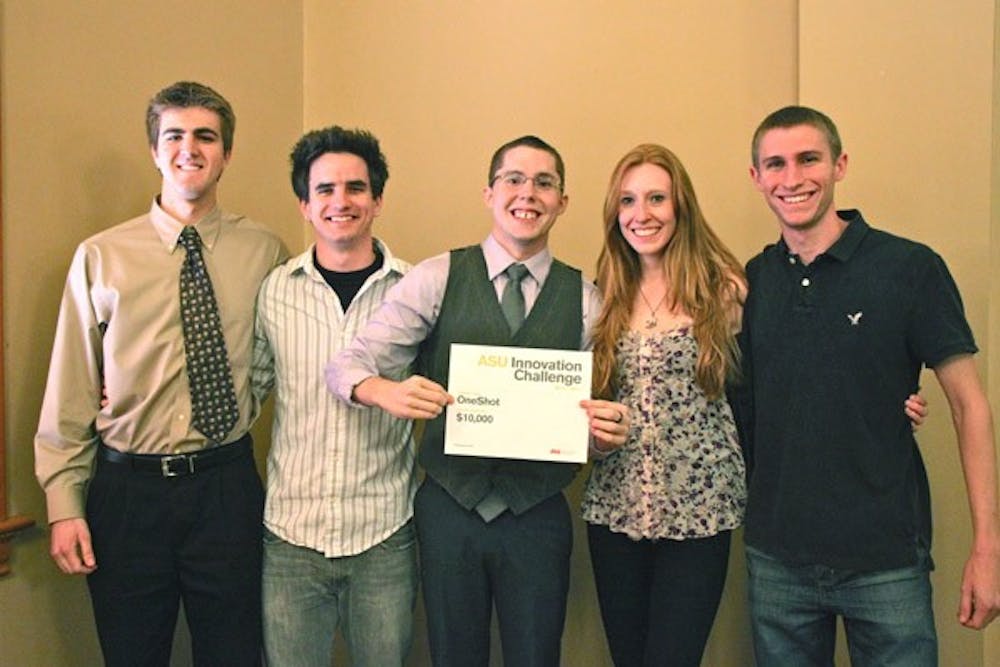Powering cell phones in Africa with leftover charcoal from a fire sounds like a piece of science fiction. But it was just one of 16 creative grant proposals announced at ASU’s Innovation Challenge Wednesday.
ASU’s Innovation Challenge, a contest that funds practical solutions to local and global problems, granted $48,000 in award money to students.
Charlie Lewis, the vice president of Venture Development at the Venture Catalyst, an ASU initiative that prepares students to start businesses after graduation, praised all the students for their proposals.
“Transforming the seed of an idea into a well-articulated business plan and into a subsequent review in front of a panel of entrepreneurs and business folk is certainly not for the faint of heart,” Lewis said.
The scale of the ideas ranged from a one-man project to create sensors to prevent sudden infant death syndrome to multi-year projects to turn shipping containers into pregnancy clinics overseas.
Last year funding was awarded in set amounts of $2,000 to $5,000, however, judges recommended greater freedom in distributing money. This year grants ranged from $500 to $10,000.
More than 150 teams applied in November, about 50 percent more than last year, said Audrey Iffert, who works in ASU’s Office of University Initiatives and helped organized the grant program. She attributed this jump in applications and application diversity to greater awareness about the grant and multiple workshops offered in the fall to help students apply.
A team of judges selected 30 finalists in January based on submitted proposals outlining innovative ideas, the impact of those ideas and their budgets, Iffert said.
The teams presented their ideas to a panel of judges in a five-minute elevator pitch format Tuesday.
The winning teams demonstrated well thought-out and practical ideas that would be completely new to their field, said Gemma Bulos, a judge and a global water and sanitation activist.
The team OneShot won the largest grant of $10,000 for their nonprofit model to provide one meningitis vaccine to a person in Africa for every vaccine provided to a U.S. college student.
Daylight Solutions, a return winner, plans to create an alternative energy source that uses charcoal to charge batteries for cell phones and light sources, said David Metoyer, the team leader and a finance and sustainability junior.
This alternative energy source will help farmers in rural Africa to communicate with one another where traditional infrastructure is not available.
The team won $4,700, and Metoyer said the money would help relieve some of the pressure to seek funding from business investors right away, allowing them to develop their idea more fully.
“It probably would have happened without the innovation challenge, but this puts us in a much better position,” Metoyer said.
Engineering junior Peter Seymour won $2,000 to develop a wrist sensor worn to prevent sudden infant death syndrome by monitoring vital signs and sounding an alarm when they were slowing.
He said his idea was inspired by a personal experience with SIDS in his family, and that the grant gave him more opportunities than funding through the Ira A. Fulton Schools of Engineering.
“Now it’s an idea I want to pursue in my life rather than an assignment for class,” Seymour said.
The Innovation Challenge grant is funded in part by a five-year $5 million grant to ASU from the Ewing Marion Kauffman Foundation, an organization that supports entrepreneurship nationally.
It is also supported by James Culver, the former vice president of operational finance for Allied Waste Industries.
Iffert said the grant program would be looking for new sponsors because they are nearing the end of the five-year Kauffman foundation grant.
“I think a lot of people identify with it because it’s about affecting change in the community,” Iffert said.
Culver, who also acted as a judge, said receiving more funding for the program was likely.
“We just need to get out there and communicate the importance of what’s happening,” Culver said.
Reach the reporter at mary.shinn@asu.edu





